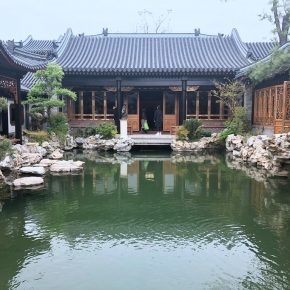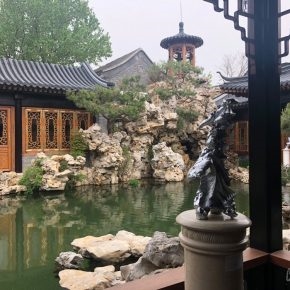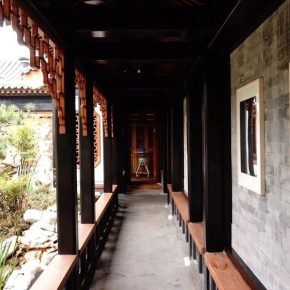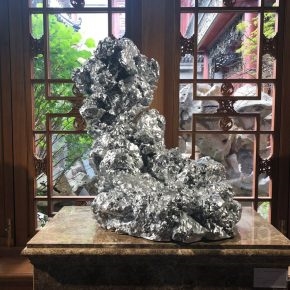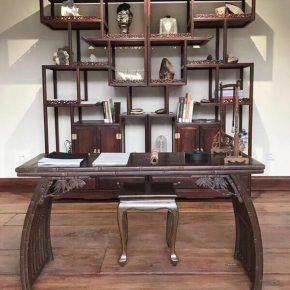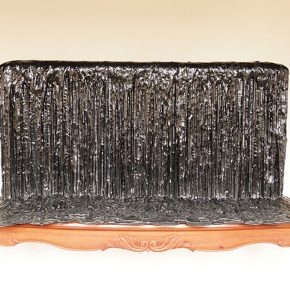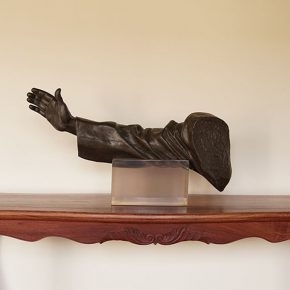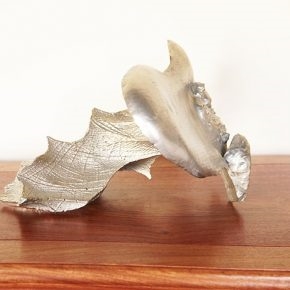
“When art embraces virtual technology and enters a game similar to Nature, and takes a pause in a garden space, it is also an occasion when time stops. The theme of this exhibition is thus formed.” At the day of Grain Rain, a garden outside the Forbidden City, Fusion Art Center, showcased some work like rockery stones which were Sui Jianguo’s “Cloud Garden” series, they were integrated with the scenery in the garden with poetic significance.
In 2008, Sui Jianguo gave up his existing habits and productive will then blindfolded he started to make “Blind Portrait”. Then, with the help of the virtual storage in the drive, the traces of his hand are enlarged and printed, he then took the meaning of “cloud” from the drive storage (in Chinese 云)and named it “Cloud Garden”.
This series of works is displayed in several open spaces around the landscape pool of the Fusion Art Center, echoing the rockery stones and creating a “field” with multiple meanings. For the spectators, it is a scene that blends while triggering thoughts; for the space, it is a venue that enables the work to communicate effectively with the audience; for the artist, it is the present state that conveys effective communication without personal interpretation. For curator Xia Kejun, this “field” has shaped a new “appreciative value.”
For the exhibition at the Fusion Art Center, it is the first time that Sui Jianguo has left the restriction of “White Box” space. The audience is greeted by more than 30 static works created by the artist since the 1990s. On the opening day, after going through several hutongs and alleys, the hidden space between the blue bricks and black tiles could be found, the only thing that can be identified is the logo on the threshold. For newcomers, they might misunderstand a visit to an old Beijing courtyard. Walking through the door, following the sound of the water, spectators find that it is a garden landscape surrounded by a pool. Sui Jianguo’s works have been meticulously arranged. This meditation space, which is a combination of daily life and artistic display, is as the curator said: “In walking back and forth between the courtyards, in the distance between the distant and the nearby, one illusion between ‘the likeness and dissimilar’, a significant ‘painting-like’ poetic atmosphere was naturally born."
The small hall on the left side of the door is set up as a “l(fā)iterati study.” In this space, the first thing on the right side of the shelf that might attract attention is, “Clothes Vein Study”, which is represented by an arm that is separated from the body and echoes the works on the scene of hand-made sculptures. Through the guidance of the arm, we noticed that the small shelf of antiques display the conch fossils, wood fossils dating back hundreds of millions of years; the stone axe, stone slabs and stone knives made by ancient humans in the Stone Age. The representative works of the artist in different periods, “Maosuit”, “Blind Portraits”, “Cloud Garden”, etc., have also been reduced to a size for us to play with and were showcased. These natural things that have been silenced in the passage of time and artifacts generated by technical means remind us that: in the current age that contemporary tends are increasingly technological, we can learn from nature and restore technologies to art. In the work on the left side, “The Memory of Sediment”, the artist places the stone in the cage, which in a Chinese cultural context symbolizes spirituality and is endowed with spirit after being influenced by the artist’s concept and it achieves a complete transition of art from a technological reference point of view.
Along the route, at the cloister, the curator is reminded that what has actually been hung on the walls are what the artist calls the “Sketch” series. Displaying them here is a simulation of the window decoration in the garden, and it also echoes the color of the garden with the dark enamel.
Through the corridor to the main hall of the exhibition space, the largest group of works in this exhibition is displayed. The two opposite walls hang a series of “Sketch” series of works. These are displayed here, which responds to several works displayed in the cloister, and also echoes the exhibition space with the color selection of the works. On the wooden floor, there is a two-meter 3D printed work “Cloud Garden—Meteor”. The artist showed us the initial mud from this piece. The thumb-sized mud was placed between the palms. The viewers all exclaimed that it was such a small form. If it was a retrospective of Sui Jianguo’s creation of the “Blind Portrait” in the past decade, “enlarging” is the core verb of his creation. This space shows the latest work of Sui Jianguo, “3D Face #2”, which is also the artist’s printed enlargement of the size of the soya bean mud. The former magnifies the artist’s mud-shaped hand texture, which presents a triangular face in the 3D digital language. For Sui Jianguo, when hand-made manuscripts were delivered to 3D printing, technical accidents made the work beyond the individual unconsciousness, thus adding technical unconscious factors.
Through magnifying and printing the work, Sui Jianguo claimed that this is a complex monument, and it is also an unconscious state. In the late 1980s, when he realized that the academic tradition was intended to train students into sculptors who could make large monuments, he took a different approach and focused on the study of metal, stones, sleepers, rubber and other materials. Later, from the perspective of deconstruction, he magnified the image of the Mao Suit, the slave plaster, and the dinosaur toy into sculptures. When he began to make “Blind Portrait” and “Cloud Garden”, he discovered that the monumental scale became a natural reflection of the ego, so he “will no longer fight against another, no longer dispel them but makes his creation become a process of self-affirmation and self-confirmation.”
From the main hall to the final space of the exhibition, there is a miniature version of the work “Gravity Field—Black Forest” which was customized for the Pace Beijing Gallery. The work is inspired by the artist’s love for German classical music. He personally went to Heidelberg and the Black Forest to experience German culture. He believes that it is German classical music and classical philosophy that makes the whole German nation completely awake and become an important part of civilization. What he wants to do is visually present the greatness of German classical music and classical philosophy. The streamlined shape of the work and the black of the whole body are blended into the landscape. Cultural differences and conflicts between China and Germany have achieved a balance in this “field” through integration with the environment.
The works of Sui Jianguo in different periods are fully incorporated into our perspective along the route. The series of “Cloud Garden” are displayed in the open space of several exhibition areas. Later in the afternoon, when the grey sky clears, and a few rays of sunlight before the sunset falls on stones and the shadows are reflected in the water, another landscape of “l(fā)ingering clouds” is formed. This is both a coincidence and the start of a new aesthetic relationship.
Text by Yang Zhonghui, translated and edited by Sue/CAFA ART INFO
Photo by Yang Zhonghui and the Organizer


